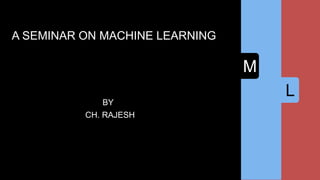
Machine learning
- 1. L M SA SEMINAR ON MACHINE LEARNING BY CH. RAJESH
- 2. WHAT IS MACHINE LEARNING? • It is learning from examples and experience. • “A field of CS, gives computers the ability to learn without being explicitly programmed.” - Arthur Samuel (1959) • A type of AI that allows applications to become more accurate in predicting outcomes. • Basic premise is to build algorithms that can receive input data and use statistical analysis to predict an output value(in acceptable range). • Machine Learning uses deep learning to arrive at the results.
- 4. TYPES OF MACHINE LEARNING • Supervised (inductive) learning – Training data includes desired outputs • Unsupervised learning – Training data does not include desired outputs • Semi-supervised learning – Training data includes a few desired outputs • Reinforcement learning – Rewards from sequence of actions
- 5. SUPERVISED LEARNING • Supervised algorithms require humans to provide both input and desired output • Once training is complete, the algorithm will apply what was learned to new data.
- 6. UNSUPERVISED LEARNING • Unsupervised algorithms do not need to be trained with desired outcome data. Instead, they use an iterative approach called deep learning to review data and arrive at conclusions. • These algorithms are particularly useful in cases where the human expert doesn’t know what to look for in the data. • Example: - Facebook's News Feed • Diabetic Retinopathy
- 7. BASIC PARADIGM • Observe set of examles: training data • Infer something about process that generated that data. • use inference to make predictions about previously unseen data: test data
- 8. WHY MACHINE LEARNING? • Develop systems that can automatically adapt and customize themselves to individual users. – Personalized news or email filter • Develop systems that are too difficult/expensive to construct manually because they require specific detailed skills or knowledge tuned to a specific task. • Discover new knowledge from large databases. (data mining).
- 9. APPLICATIONS OF MACHINE LEARNING
- 10. AREAS OF MACHINE LEARNING
- 14. GOAL OF MACHINE LEARNING • The goal of machine learning is never to make “perfect” guesses but to make guesses that are good enough to be useful. • Machine Learning builds on statistics. • That means when we train our machine to learn, we have to give it a statistically significant random sample as training data. • If the training set is not random, we run the risk of the machine learning patterns that aren’t actually there. And if the training set is too small, we won’t learn enough and may even reach inaccurate conclusions.
- 15. AWESOME PRODUCTS OF MACHINE LEARNING • Tensorflow • IBM Watson • Google Cloud Platform • Cozmo - a robot built using Machine Learning • Nvidia BB8 - learns how to drive by watching drivers • AlphaGo by Deepmind - Google DeepMind’s AI(Machine Learning) software AlphaGo played world Go champion Lee Sedol. (Go is 2500 year old 19 x 19 chinese game which has more possible positions than there are atoms in the universe)
- 16. LATEST INVENTIONS • Google has built Tensor Processing Units (TPU) to meet the scale at which computing should be done for machine learning. • Watson is a question answering computer system capable of answering questions posed in natural language, developed in IBM's DeepQA project by a research team led by principal investigator David Ferrucci.The computer system was specifically developed to answer questions on the quiz show Jeopardy! and, in 2011, the Watson computer system competed on Jeopardy! against former winners Brad Rutter and Ken Jennings winning the first place prize of $1 million. • Watson had access to 200 million pages of structured and unstructured content consuming four terabytes of disk storage including the full text of Wikipedia
- 17. THANK YOU
